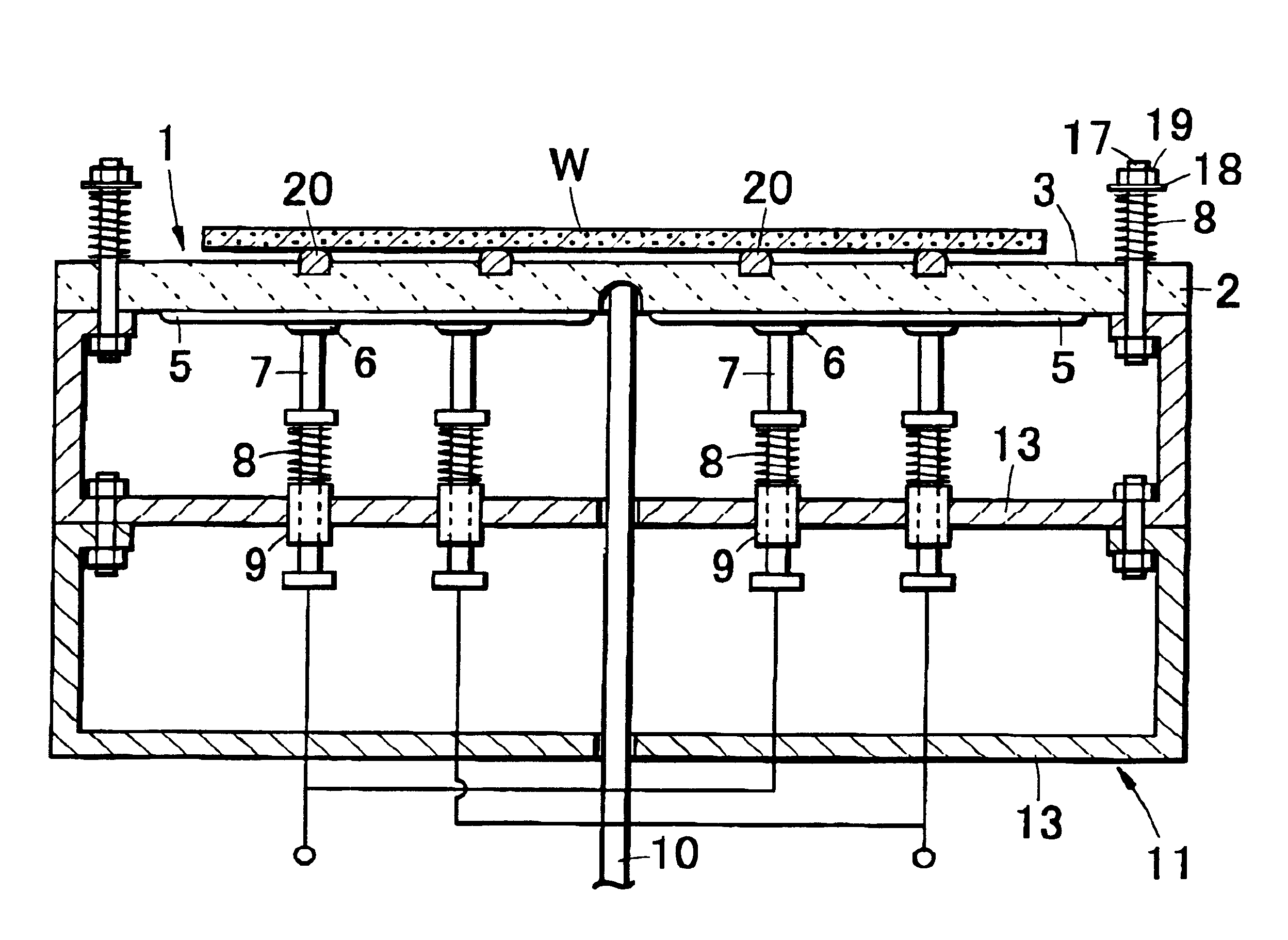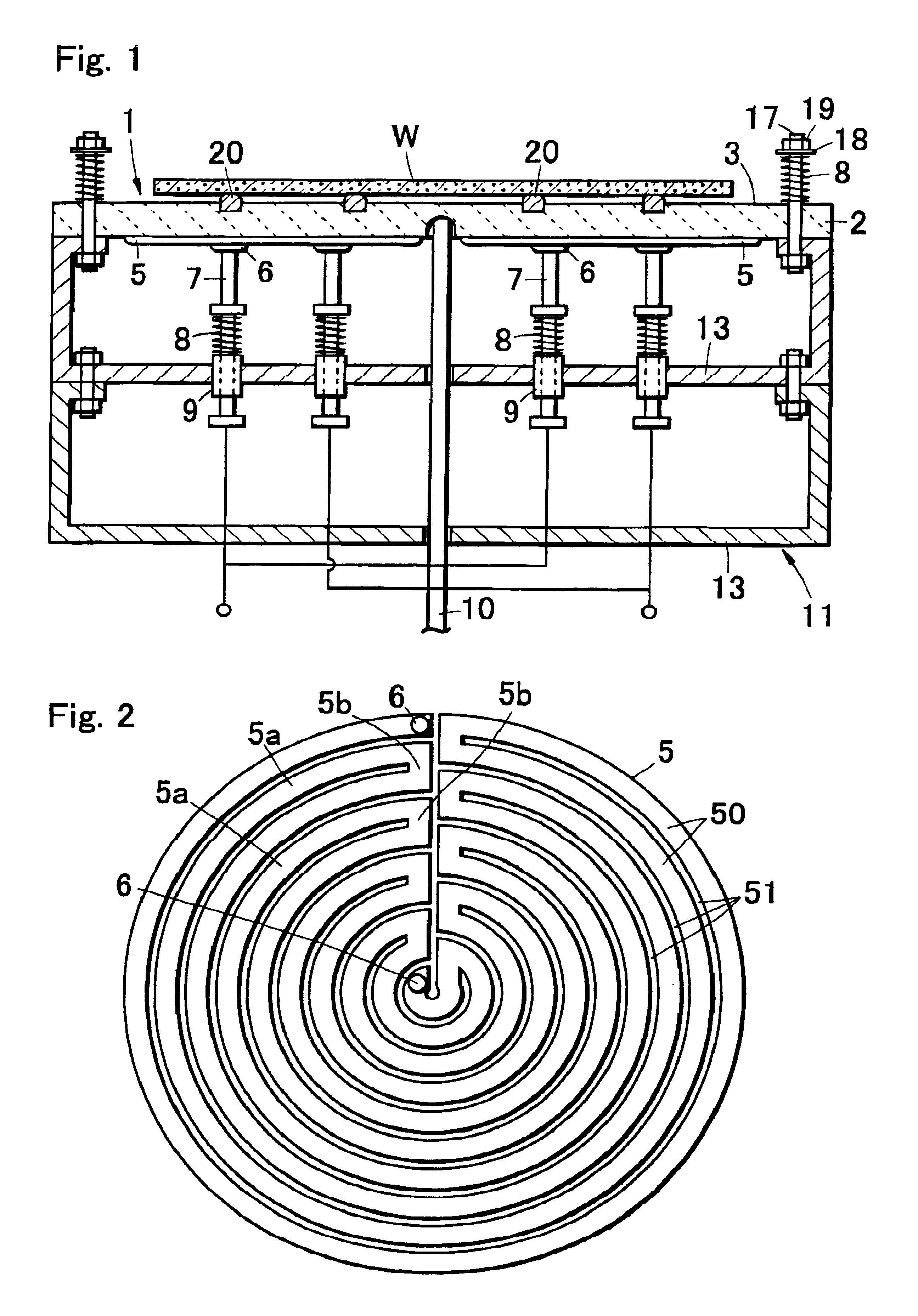Wafer heating apparatus
a heating apparatus and a technology of a wafer, applied in the direction of ohmic-resistance heating, hot plate heating arrangements, coatings, etc., can solve the problems of long response time to the altered set temperature, insufficient moderated temperature distribution of the heating element, and long time-consuming to achieve the effect of heating and cooling to a set temperatur
- Summary
- Abstract
- Description
- Claims
- Application Information
AI Technical Summary
Problems solved by technology
Method used
Image
Examples
embodiment 1
A plurality of heat homogenizing plates 2 with a disk-like shape of 3 mm thickness and 340 mm outer diameter were produced by grinding and polishing a silicon carbide sintered-based body with a thermal conductivity of 100 W / m / K and in order to form an insulating layer 4 on one main face of each heat homogenizing plate 2, a glass paste produced by kneading a glass powder with ethyl cellulose as binder and terpineol as an organic solvent was applied by a screen printing method and heated to 150.degree. C. for drying the organic solvent. After that, degreasing treatment was carried out at 550.degree. C. for 30 minutes and further baking was carried out at a temperature from 700 to 900.degree. C. to form the insulating layer 4 of glass with a thickness of 200 .mu.m. Then, in order to form a heating element 5 on the insulating layer 4, a paste produced by mixing 20% by weight of a Au powder and 10% by weight of a Pt powder as conductive materials, 70% by weight of glass, and prescribed a...
embodiment 2
A plurality of heat homogenizing plate s 2 with a disk-like shape of a thickness of 3 mm and an outer diameter of 300 mm, 315 mm, 340 mm, and 375 mm were produced by grinding and polishing a silicon carbide sintered-based body with a thermal conductivity of 100 W / m / K and in order to form an insulating layer 4 on one main face of each heat homogenizing plate 2, a glass paste produced by kneading a glass powder with ethyl cellulose as binder and terpineol as an organic solvent was applied by a screen printing method and heated to 150.degree. C. for drying the organic solvent. After that, degreasing treatment was carried out at 550.degree. C. for 30 minutes and further baking was carried out at a temperature from 700 to 900.degree. C. to form the insulating layer 4 of glass with a thickness of 200 .mu.m. Then, in order to form a heating element 5 on the insulating layer 4, a paste produced by mixing 20% by weight of a Au powder and 10% by weight of a Pt powder as conductive materials, ...
embodiment 3
An alumina sintered body of a thermal conductivity of 30 W / m / K, an aluminum nitride sintered body of a thermal conductivity of 50 W / m / K, and silicon carbide-based sintered bodies of a thermal conductivity of 80 W / m / K and 150 W / m / K, respectively, were employed. These sintered bodies were ground and polished to produce a large number of heat homogenizing plate s 2 with a disk-like shape of 1 mm thickness and 340 mm outer diameter.
In order to form an insulating layer 4 on one main face of each heat homogenizing plate 2, a glass paste produced by kneading a glass powder with ethyl cellulose as binder and terpineol as an organic solvent was applied by a screen printing method and heated to 150.degree. C. for drying the organic solvent. After that, degreasing treatment was carried out at 550.degree. C. for 30 minutes and further baking was carried out at a temperature from 700 to 900.degree. C. to form the insulating layer 4 of glass with a thickness of 200 .mu.m. Then, in order to form a...
PUM
| Property | Measurement | Unit |
|---|---|---|
| thickness | aaaaa | aaaaa |
| distance | aaaaa | aaaaa |
| outer diameter | aaaaa | aaaaa |
Abstract
Description
Claims
Application Information
 Login to View More
Login to View More - R&D
- Intellectual Property
- Life Sciences
- Materials
- Tech Scout
- Unparalleled Data Quality
- Higher Quality Content
- 60% Fewer Hallucinations
Browse by: Latest US Patents, China's latest patents, Technical Efficacy Thesaurus, Application Domain, Technology Topic, Popular Technical Reports.
© 2025 PatSnap. All rights reserved.Legal|Privacy policy|Modern Slavery Act Transparency Statement|Sitemap|About US| Contact US: help@patsnap.com



